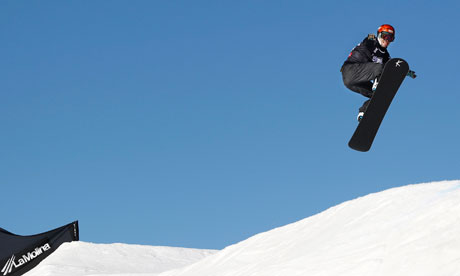
Enmity on the slopes between skiers and snowboarders is long running, and has now been exacerbated by a study to find which sport is more dangerous.
Research for the National Ski Areas Association in the US claims to have settled the question: snowboarding has less risk of ending in serious injury.
Jasper Shealy, a professor emeritus at the Rochester Institute of Technology who has studied such injuries for 40 years, concluded that while snowboarders were between 50% to 70% more likely to get injured, they are also around a third less likely to be killed on the slopes than skiers. Most of the skiing deaths were "due to collisions with fixed objects, where somebody is going at a relatively high speed", said Shealy, speaking as tour operators predicted that 2011 could be a bumper year after the heavy snowfall since November prompted European and North American resorts to open early – though they have seen a trend towards booking late for the best snow.
The lower injury count in skiing may be due to advances in safety releasing equipment; in the 1970s broken legs were common because skis would often not come off at the right time. Today, he said the injury is "almost non-existent".
He added: "When a snowboard rider falls, the edge of the snowboard drags on the snow and acts like a brake. But that can also cause fractures."
Spencer Claridge, who organises British ski and snowboard championships, said the fatalities were explained by the differences in the sports. "If you can walk you can ski, so it's easy to get out of control and go careering into a tree at a rate of knots. Learning how to go fast on a snowboard takes longer."
James Stentiford, a pro snowboarder, said the culture of snowboarding was different. "Skiing is all about racing, even if it's just to see who's the first back home. Snowboarders are more focused on manoeuvres: jumps and tricks, which are done at a slower pace. Though naturally, it's easier to get hurt doing them."
Shealy's report has its opponents. Cat Weakley, deputy editor of the Daily Mail Ski and Snowboard Magazine, said it focussed on the wrong data. "I don't think either sport is intrinsically more dangerous than the other. It depends on the skier or snowboarder as a person – if he or she is cautious or reckless."
The study does have one piece of uncontroversial good news: head injuries have declined by 50% since 1999, a statistic attributed to the increase in helmets being worn on the slopes. "I think a few high-profile head injuries have helped spread the word," says Stentiford. "Here in Chamonix [France], you see people with a backpack, goggles and a helmet. It's the mountain uniform now."
The injury report comes out against a mixed picture for the snow sports industry. "I wouldn't say there was downward trend in sales, but we're definitely seeing a change in booking trends," says Lisa Tyrrell of Inghams Holidays. "People are booking later, and are preferring to stick to the classic European resorts in France and Austria especially."
Jessica Prior of snowboardclub.co.uk says her users are becoming internet savvy when it comes to the best snow. "Our members on the forums are reporting exceptional snow in Breckenridge [Colorado], Jackson Hole [Wyoming], Mammoth [California], and in the French Alps. Things like airport transfers have been hot topics on the forums as people hunt the best conditions using low cost airlines and late accommodation deals."
And perhaps climate change is having an effect. Skiing columnist Gabriella Le Breton says she has never seen so much snow so early, though the conditions have been changeable "The temperatures have been erratic. I went from minus 33 in Gstaad [Switzerland], to plus 3 degrees in Val d'Isere [France], in a matter of days. But such melt-freeze cycles make for a solid base to ski on."
Three tips for avoiding injury in each sport
Snowboarding
• "Impact shorts" look like padded underwear and help snowboarders absorb falls and keep cold chairlifts at bay.
• Wrist guards can spread impact shocks and help prevent broken bones.
• Modern helmets are light and provide great protection against the dreaded "heel edge catch".
Skiing
• Correctly setting the ski binding's DIN release mechanism can prevent bone, ligament and tendon damage in the lower leg.
• Shorter skis can lower the leverage on legs and help prevent tibia and fibia breaks.
• A five-minute warm-up can relax tendons, ligaments and muscles.

